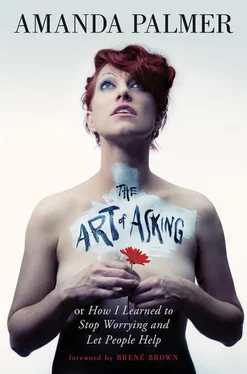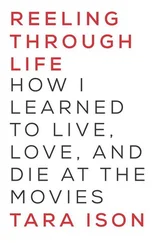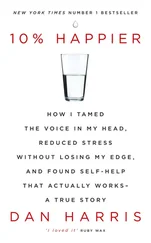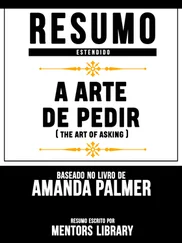Can’t afford to hire a full choir of people? Send out a blog and have your fans come in and sing with you. They may sound amateur, but it’ll be fun, and people love being on a record .
Car runs out of gas on a long stretch of road? Put your thumb out. Someone will eventually give you a lift .
As you can see, the underlying philosophy is actually the same:
Limitations can expand, rather than shrink, the creative flow.
Minimal DIY doesn’t rely on trust; it relies on ingenuity.
Maximal DIY relies on trust and ingenuity. You have to ask with enough grace and creativity to elicit a response, and you also have to trust the people you’re asking not to ruin your recording session, not to poison your food, not to bludgeon you with a hammer as you sit in their passenger seat.
• • •
We hung out and signed merchandise after every show in every town, Pink-Dots-style, and a natural outgrowth of our beginnings in which the audience had blurred with our circle of friends. If we wound up getting kicked out of a venue because we’d hit curfew and we hadn’t finished signing things, we’d parade the remaining fans outside and finish in the street.
We signed our CDs, of course, and shirts and posters, too—usually with a black or silver Sharpie. But we also signed: phone cases, playing cards, sneakers, reading glasses, Bibles, passports ( You know this is illegal, right? ), purses, faces ( please don’t get that tattooed ), armpits, puppets, babies ( please don’t get that tattooed, either ), feet, shot glasses, teakettles, security blankets, breasts, and once, a guy’s penis (it was not erect). And one time, in Santa Barbara, Brian signed a girl’s anus. Everyone was impressed.
I asked him to please throw that particular Sharpie in the trash.
People loved giving us art they’d made. Sometimes the signing line would create art collisions unwittingly, like the time a girl at the front of the line gave me an anatomically correct, life-sized, gorgeously hand-knitted vagina, and a guy at the back of the line gave me a little plastic astronaut toy from the 1980s that nestled perfectly into the vulva. Somebody else in the line had a twist tie and threaded them together more tightly. They live, in harmony, on my kitchen shelf at the Cloud Club and have never been separated since that day.
In the early days, we talked to people for as long as they wanted, about whatever they wanted. Once we started touring internationally, these signings would sometimes last longer than the show itself; we’d sometimes play for two hours and sign for two and a half.
In retrospect, the act of signing was far more significant than I realized in the moment. Especially in the early days, when we were playing in small clubs, I was actually AFRAID of the audience. Not afraid they would hurt me, or throw glass bottles at my head (which DOES happen in some genres of music). I was just afraid of their judgment. We were only just starting to get criticized on the hipster music websites for being too gay, too dramatic, too female, too screamy, too lame, too goth. I would imagine that the strangers out there beyond the footlights were the same entities who were judging us in the snarky corners of the music blogs. I feared the critics. In my head, the critics and the crowd were one and the same.
As I played and looked out into the crowd, I could see clearly that the people in the front rows loved us, since they were mouthing the words to our songs, banging their heads, throwing their fists in the air. But what about the people in the ninth, tenth, and twentieth rows? I couldn’t see them . I imagined them all standing there with their arms crossed, rolling their eyes at our gay mime antics, waiting to be sufficiently impressed.
Signing fixed that, because we got to meet a pretty decent percentage of the audience every night. They weren’t judgmental hipsters. They were just sweet, human, smart, fumbling people like Brian and me, all of whom had kind faces and, usually, their own strange stories to tell. After hundreds of nights of signing, my instinct to fear the audience was worn away, like running water smoothing down a jagged rock.
It was an epiphany: Holy shit. They’re not scary at all. They’re just… a bunch of people .
It just wasn’t possible to feel that anxious anymore: I’d MET them. But I never would’ve known if I hadn’t made the effort to stand at the merch table every night; I might have stayed afraid for years. And when you’re afraid of someone’s judgment, you can’t connect with them. You’re too preoccupied with the task of impressing them.
• • •
Once we had enough money to be choosy, I turned down the option of using a real grand piano. Too much fuss to transport, rent, and tune, too hard to fit onstage, too hard for Brian to see my exact hand movements when we played. But most importantly, turning my head to the side to address the audience felt alienating. I wanted to look straight at them. I wanted to see them.
The typical electric keyboard stand is pretty ugly, though, so along with the tea, honey, hummus, and juice that our contract required from the ever-larger venues we were playing, I asked for a few bunches of flowers every night, so we could tape them to the keyboard stand to hide the ugliness. We often had flowers left over, though, and it seemed like a waste to leave them in the dressing room where they’d just be thrown away. Some divas get flowers thrown at them, but we started a tradition of pitching flowers at the audience when we first took the stage; a love assault of foliage. We started requesting that the flowers have absolutely no thorns, for safety. With some effort, we could usually hit people in the balcony.
People started bringing bouquets to the shows and passing them through the crowd up to the lip of the stage for use between songs, or throwing them at our feet, true diva style, at the start of the show. We would rip them up into manageable chunks and throw them back out to the crowd. The crowd would toss them back at the stage.
This game could last all night.
Later, in the signing line, people would take the flowers from behind their ears and hand them to me as a thank-you gesture. Then I’d recycle the same flower to someone down the line who looked lonely or in need of some extra love.
On a good night, you couldn’t tell who was giving what to whom.
• • •
Sharing my life on the Internet has meant that everybody knows the immediate score of my existence. Fans in the signing line will ask, How’s Neil? Did he get to his plane on time? And, How’s your chest infection—have you finished that run of antibiotics? I’m on the road and they’re on home turf. They bring books, herbs, teas, soaps, beers from the bar, organic wines from the region. The edible items are usually shared with the people standing behind them.
The signing line is a cross between a wedding party, a photo booth, and the international arrivals terminal at the airport; a blurry collision of flash intimacies. It’s a reunion with those I haven’t met yet. There are a lot of tears and a lot of high-fiving and a lot of hugging. There’s also a lot of asking, in both directions.
Will you take a picture for us?
Will you take a picture with us?
Do you need a hug?
Can I have a drink?
Do you want a drink?
Will you hold my drink?
Why are you crying?
It’s not always the fans crying. I’ve been held by many fans on nights I needed a random shoulder on which to collapse.
I’ve observed signing lines at other concerts that are not like this, where it’s all business and security officers stand there making sure nobody touches The Talent. I’ve had to argue with security officers appointed to my signing lines, explaining that, unlike other bands, we don’t WANT security to hurry people along, or shoo them away, making sure they don’t stop to talk. I need people to stop and talk and hug me, or else I feel like an automaton.
Читать дальше












